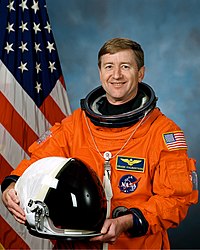Frank Lee Culbertson
| Frank Culbertson | |
|---|---|

|
|
| Country: | United States |
| Organization: | NASA |
| selected on | May 23, 1984 (10th NASA Group) |
| Calls: | 3 space flights |
| Start of the first space flight: |
November 15, 1990 |
| Landing of the last space flight: |
December 17, 2001 |
| Time in space: | 143d 14h 50m |
| EVA inserts: | 1 |
| EVA total duration: | 5h 05m |
| retired on | August 2002 |
| Space flights | |
Frank Lee Culbertson, Jr. (born May 15, 1949 in Charleston , South Carolina ) is a retired American astronaut .
Culbertson graduated from the United States Naval Academy in 1971 and received a bachelor's degree in aerospace engineering. He then served aboard the USS Fox in the Gulf of Tonkin before coming to Pensacola for flight training .
As a Navy aviator, he flew various types of aircraft at several locations and on aircraft carriers from 1973 until he came to the US Naval Test Pilot School in Patuxent River (Maryland) in May 1981 . From 1982 he worked as a program manager and test pilot for the Strike Aircraft Test Directorate until he finally came to NASA in 1984. He has over 6000 hours of flight experience with 40 different aircraft and completed 350 landings on aircraft carriers.
Astronaut activity
Culbertson was selected by NASA as a space pilot in May 1984. His astronaut basic training lasted until June 1985. He was then involved in the further development and tests for the control, tires and brakes of the shuttle nose wheel. He was a member of the support teams at the Kennedy Space Center for shuttle flights STS-61-A , STS-61-B , STS-61-C, and STS-51-L . In 1986 he worked at NASA headquarters in Washington, DC on the investigations into the Challenger disaster.
He became head astronaut at the Shuttle Avionics Integration Laboratory (SAIL), head of the group investigating the possibility of exiting the space shuttle in the event of an emergency and as CapCom in the Mission Control Center , he oversaw seven missions: STS-27 , -29 , -30 , - 28 , -34 , -33 and -32 . He also worked for both the Shuttle Mir program and later for the International Space Station program .
STS-38
Culbertson took off on the space shuttle Atlantis on November 15, 1990 for its first mission, STS-38, on behalf of the US Department of Defense . A military spy satellite was deployed as a payload.
STS-51
On September 12, 1993 he flew into space with the Discovery for the STS-51 mission and deployed the Advanced Communications Technology Satellite (ACTS) and the Shuttle Pallet Satellite ( ORFEUS-SPAS ). The latter American and German scientific experiments had including an ultraviolet - spectrometer on board. In a seven-hour spacecraft mission , his colleagues James Newman and Carl Walz tested tools and methods for repairing the Hubble space telescope . After ORFEUS-SPAS had flown freely for six days and had moved approx. 65 km away from the Discovery, it was finally caught again with the help of the space shuttle's robotic arm. After 158 orbits around the world, the Discovery was the first shuttle to land at the Kennedy Space Center that night.
ISS expedition 3
On board the Discovery , Culbertson started on August 10, 2001 as a member of the third long-term crew for the International Space Station (ISS) . On August 12, 2001, he docked with the space shuttle at the ISS to work there a total of 129 days, 117 of which (from August 17) as a commander. On November 12, Culbertson and Vladimir Deschurow installed 7 telemetry cables for the course's automatic coupling system during a space exit, completed the installation of the Strela crane and inspected a solar cell panel on the Zvezda module that was not exactly unfolded . On December 15, 2001, the third long-term crew left the station and landed with the space shuttle Endeavor ( STS-108 ) on December 17, 2001 at the Kennedy Space Center.
Private
Culbertson has two grown children with his second wife, Rebecca Ellen, and three children from their first marriage.
See also
- List of spacemen
- List of space shuttle missions
- List of manned space flights
- List of ISS expeditions
- List of manned missions to the International Space Station
Web links
- Short biography of Frank Lee Culbertson at spacefacts.de
- NASA biography of Frank Lee Culbertson (English; PDF)
- Biography of Frank Lee Culbertson in the Encyclopedia Astronautica (English)
| personal data | |
|---|---|
| SURNAME | Culbertson, Frank Lee |
| ALTERNATIVE NAMES | Culbertson, Frank Lee Junior (full name) |
| BRIEF DESCRIPTION | American astronaut |
| DATE OF BIRTH | May 15, 1949 |
| PLACE OF BIRTH | Charleston , South Carolina |